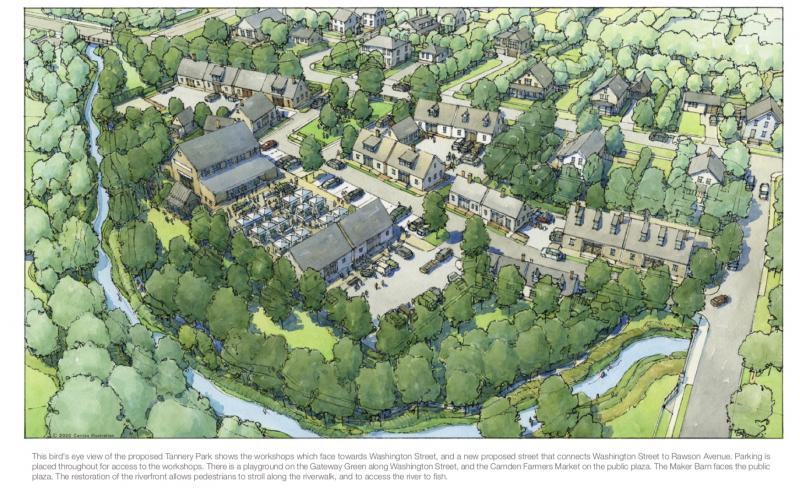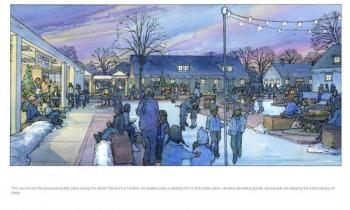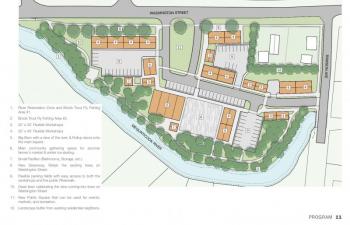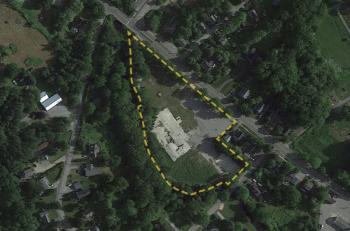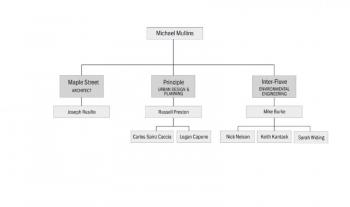CAMDEN — The challenge of what to do with Camden’s lien-acquired former tannery land on Washington Street has been decades long in meeting, and heavily scrutinized. But it is inching closer to redevelopment following a March 23 Select Board vote, albeit a split vote, which directed the town manager to negotiate purchase and sales agreement with a Cranesport LLC.
Intrinsic to the decision is a municipally-lead push to increase Camden’s housing opportunities in an overheated real estate market.
Select Board Chair Robert Falciani likened the March 23 conversation, “a crowbar to open the door to the issue of affordable housing.”
Board members voting in favor of Camden deliberating the terms of a purchase and sales agreement for the Tannery were Falciani, Alison McKellar and Taylor Benzie; opposing were Jenna Lookner and Marc Ratner. If the agreement is fashioned so that the Select Board approves, it is to appear on the June town warrant before Camden voters to approve or reject.
The voted followed a lengthy discussion about the recent positions of both Michael Mullins, a principal of Cranesport, and Northlands-Dovetail, the competing business entity that proposed an housing complex on the tannery site.
This particular phase of the progress has followed a lengthy but process-oriented route. In 2020, the town circulated requests for proposals for the redevelopment of the tannery site after years of cleaning the former brownfield and entertaining ideas of possible new ownership, projects there and redevelopment plans. The 3.5-acre brownfield had landed in the town’s lap in 2003 after nonpayment of taxes by the Apollo Tannery, which closed its tanning business in 1999, following a fire and financial problems.
Four responses to the RFP were received and collected on this municipal web page.
The town’s Community and Economic Development Committee then stringently analyzed the proposals, and the Select Board then reviewed CEDAC’s subsequent recommendations, as well as raising its own questions.
Two front runners, Cranesport and Northland, emerged, and the board then asked those two entities follow-up questions.
For Cranesport, which had proposed transforming Tannery Park to an industrial eco-village with a common market, incubator spaces and an event venue, the town wanted to know if Mullins would also incorporate residential space.
For Northland/Dovetail Consulting, the town wanted to know if the design would be adjusted to reduce the density of the proposed Millville apartment complex, with its 35-50 units.
Mullins told Camden he would explore a revision to the northwest corner of the Tannery site that runs along Washington street, and consider a two- or three-story townhouse development with flexible retail/residential convertible commercial space on the ground floor.
Northlands responded to the town’s follow-up queries that it would still offer $80,000 for the purchase of the site, with the understanding that, “the overall financial viability of this project would certainly improve if these funds were invested back into this project,” said Caler.
Additionally, Northland would also require a TIF, and a credit enhancement agreement, as well as a zoning zoning ordinance amendment to allow for first-floor residential and to relax parking standards.
The town would be asked to invest the remaining $165,000 of the EPA Brownfields Clean Up Grant on site remediation required for the Northlands-Dovetail proposal.
Caler also explained that Northland would also face a diminished chance for affordable housing credits given that the federal Housing and Urban Development has reclassified Knox County as being less difficult to develop; hence, fewer tax credits are available.
Caler pointed out March 23 that those HUD rules change periodically, but for now it, “creates a funding gap of approximately $1 million, which in not insurmountable, but will require a stronger partnership between the Town and Northlands-Dovetail should the Select Board progress this proposal to voters and voters approve it.”
That would also mean that Northland would likely close its funding gap with: “the inclusion of market-rate rentals or condos which would be affordable to median income households, similar to the housing identified in the amended Cranesport proposal. However, in order to make the inclusion of these units feasible, this development will still need to include 30 subsidized units. Therefore, in order for Northlands-Dovetail to do a housing development that is a mix of subsidized and market rate units, the density will need to be on the higher side of what they proposed (50 units verses 35).”
The town manager advised, both in her memo and again at the March 23 meeting, that the board needed to consider a more involved partnership with either of the companies, if it wanted to expand the housing availability in Camden.
“If you want housing to be incorporated in a project, it is going to require a partnership with the developer on that site that is beyond just the town entering a purchase and sales agreement and conveying that property over,” she said, March 23. “It is a much more involvement between the town and whoever it is for housing.”
The projects, she said in her memo, “simply cannot happen without federal, state and local subsidy, which is particularly true in communities like Camden where the cost of land, labor and materials is high to begin with.”
Taylor Benzie said at the March 23 meeting that the municipality could not “over-value affordable housing; not necessarily subsidized, but affordable within walking distance of downtown.”
The board acknowledged that evening that it also is to consider two other competing housing proposals for the municipally-owned Sagamore Farm, off of Route 1 north in Camden. The board is to take up that discussion in May.
“Workforce housing is the most underserved housing,” said Benzie. “We do have Section 8 housing in Camden,” he said, but added that a gap existed between rental assistance programs, such as Section 8 and the prevalent $350,000 home in Camden.
“So, how to support that gap?” he posed to the Select Board.
Benzie advocated for moving forward with the Cranesport proposal, with the proviso that if another housing development surfaced in town that answered the community need, then the board could back off from its housing requirement for the Tannery property.
“If we find out that a miracle has happened and we can satisfy that need in a reasonably similar way, elsewhere in town, then on April 20 we could approve the purchase and sales agreement without housing,” he said.
Benzie said he favored the Cranesport vision.
“Cranesport is the best suited proposal for that site at this point,” he said.
Board member Jenna Lookner agreed with Benzie, saying the:“Cranesport proposal is exciting. I just have reservations about the ability to execute it and the developer having different goals than the town, and how much willingness there is to change things and work with us.”
She added, “We deserve, and the neighborhood deserves, to find something that isn’t just good enough.”
While board member Alison McKellar said that commercial use would be more appropriate because of the site’s environmental contamination, she said: “I agree with Taylor, that I would be comfortable with, in concept, in forcing housing to the Cranesport proposal, but ecologically, [it] might be doing too much with that site.”
She suggested adding more greenspace to the plan and less development.
“The idea that that site can be everything to everyone I don’t think works that well environmentally,” said McKellar.
Still, she advocated for getting a proposal in front of Camden voters.
“We are at the point where we could at least put something to the voters,” she said. “We could give them a bunch of information and they could decide.”
Board chair Falciani also endorsed getting an article before the voters.
“I think we owe it to the public that we recommend something,” he said. “Both are interesting, and economically most reactive to the town’s needs. This board as a whole said affordable and housing is priority. We can be looking at other options that could rear their head.”
He suggested starting off, “with a recommendation and let Audra and company work with the developer and put the flesh on the bone.”
“Sagamore Farm is a multi-year option,” said Falciani. “We need to do something sooner. We need to be creative and open up every nook and cranny to do more. I won’t support a motion to table.”
Board member Marc Ratner, however, said he favored delaying a decision.
“I think this board has been very progressive in what we have done,” he said.
But, he added, “As much as I feel need for affordable housing, I don’t believe Northland development fits the site.”
In looking at the neighborhood, he said he was, “not convinced at this point that I’m fully comfortable with the [Cranesport] proposal and the way it is laid out.”
Nor was he in a hurry.
Benzie reiterated that: “Cranesport meets guiding principles. Housing is probably our Number 1 crisis.”
His motion was to move forward with Cranesport with the housing addition the business offered, and to authorize the town manager to enter into purchase and sales agreement, in support for it to appear on the June town meeting warrant.
The board then voted 3 to 2 in favor of the motion.
Mullins, in a follow-up email exchange, said the Cranesport LLC also owns 100 Mt. Battie Street, in Camden, which is a commercial building used for different purposes.
The proposal for Tannery Park is called Tannery Park, although it has been referred to as the Cranesport Proposal.
The name Cranesport comes from the movie The Man Without a Face, which was shot in Camden and Rockport,” he said, in response to the name’s origin. “It's the name of the fictional town in the film; hence, the name.”
History of the tannery site, since 2003
“We have been talking about the tannery for years,” said Peter Gross, chairman of the Community Economic Development Advisory Committee, which was created in 2009 and charged with helping the town sell the 3.5-acre brownfield since cleaned according to state and federal environmental agency guidelines.
He said that at a 2012 Select Board meeting when the town decided to engage someone to actively sell the property.
“It was the initial issue CEDAC took up when it [the municipal committee] was created,” he said, speaking to the Camden Select Board Monday evening, Nov. 27, 2012. “The downturn in the economy did not help marketing efforts.”
The Apollo Tannery, at 116 Washington Street, had closed its tanning business in 1999, following a fire and financial problems.
In 2003, Camden acquired it in a lien foreclosure. At the 2011 Camden Town Meeting, it was characterized by one resident as “Camden Follies, Act II.”
But Camden voters agreed to invest close to $1 million to clean up it. The town demolished the decrepit buildings, removed some contaminated soil and capoed more, hoping the vacant lot would eventually provide the community with a source of enterprise and employment.
For a brief period in 2006, a Florida-based investor offered to purchase the lot for $100,000 (a deal that was terminated).
In 2008, another town committee that preceded CEDAC, the Tannery Work Group, recommended the town sell the property in accordance with guiding principles and buyer/developer qualifications. Incentives proposed by the group included supplying a "land for jobs" rebate as a means of encouraging the creation of year-round jobs.
The town wanted any potential buyer to create at least 24 new jobs, each each paying at least $40,000 in wages and benefits annually. Furthermore, preference was to given to businesses that would stimulate other new employers to come to Camden without taking customers from any already existing business in the town. A list of acceptable businesses was created, along with a list of those that should not be encouraged in the redeveloped site.
Acceptable businesses included bio-technology and life sciences; research and development; marine trades and boat building; higher education institutions; precision manufacturing and health care. Unacceptable businesses included outdoor boat storage; poultry, meat or seafood processing; auto repair shops and warehouse.
In 2009, CEDAC retained Chris Shrum and the then-Knox-Waldo Regional Economic Development Council, with the help of approximately $24,000 in marketing funds, to attract a buyer. At the same time, CEDAC began to focus on its broader mission to help Camden stimulate its economic engine and create year-round employment.
While those efforts were under way, a group of Camden residents also began working on the Camden Riverwalk, a pathway alongside Megunticook River. In 2008, Camden voters had approved creating a 25-foot-wide easement on the tannery land, keeping it forever under the feet of the public, for a walkway.
As the town and CEDAC pushed marketing the tannery site and its land for jobs concept, it placed an ad on Yahoo's financial website in 2010. B.D' Turman'd Entertainment LLC, whose principals were in Los Angeles and Milwaukee, responded, and pursued acquiring the land, proposing to construct there two sound stages to be used in film production. The deal, as crafted by the town and the LLC principals, became controversial, and LLC pulled out. Reasons for terminating a purchase and sales agreement were attributed to the overly constrictive land configuration, size, and restrictions affecting title that would make it impossible for the business to develop the studios, adequate parking, office facilities and river improvements.
Renewed interest in the parcel arose in 2014 when North East Mobile Health Services indicated interest in part of the parcel. But Aug. 26, 2014, the ambulance service announced that it was backing out of talks with Camden.
In 2014, in a close nonbinding November vote, Camden residents indicated they wanted the Tannery land to be used for commercial/business purposes. The question on the ballot was: “Do you support using the Tannery property for commercial/business uses described in the Guiding Principles approved by the Town Meeting, or do you support using the Tannery property for park/open space?”
1,429 said they wanted it kept for commercial/business use
1,360 said they wanted it used as park/open space
Those guiding principles were approved in June 2008 at Town Meeting.
Following the 2014 nonbinding referendum, the Select Board created the Tannery Work Group "to lead an inclusive, community-wide dialog to determine the preferred uses of the site."
The group was finalize objectives, rank preferences for concepts on the table, and plan for how to include the town in the discussion.
For 18 months, the Group worked, under the leadership of former town manager Roger Moody, and on March 21, 2017, the group presented its final recommendations and recommended the town pursue a federal brownfield grant to help refine the site.


